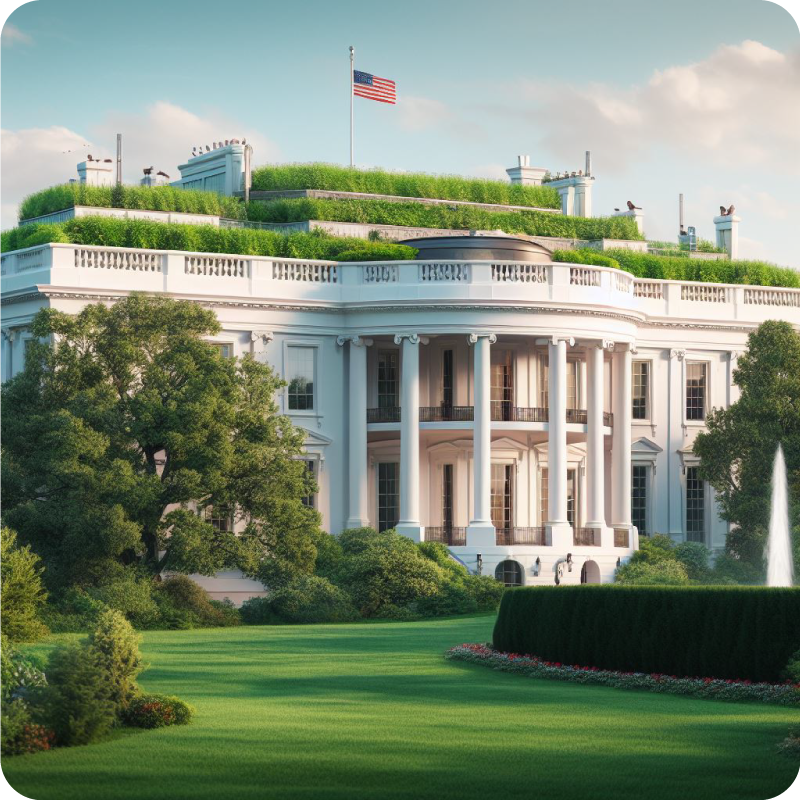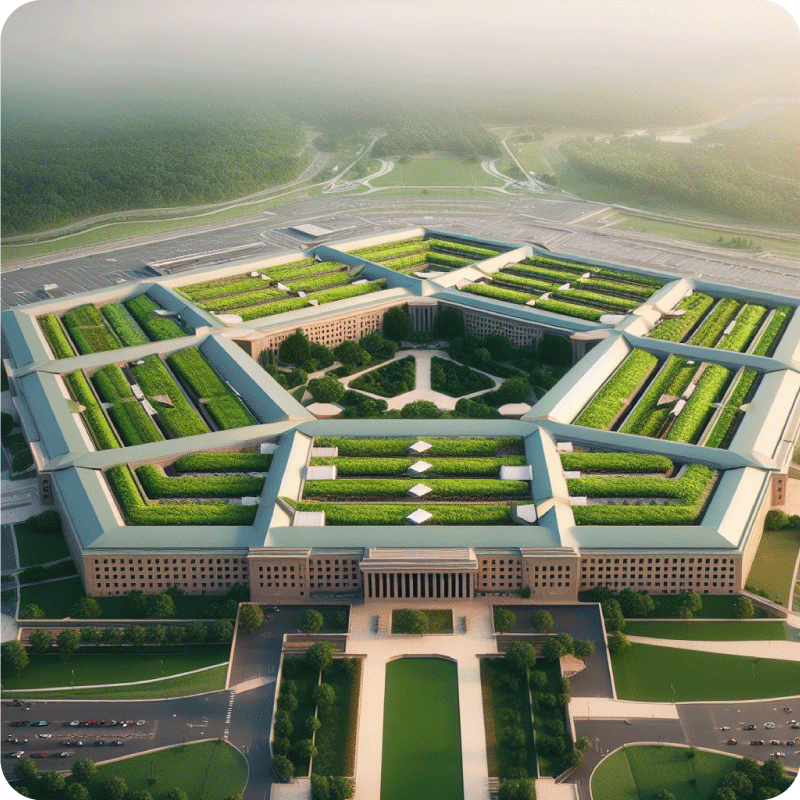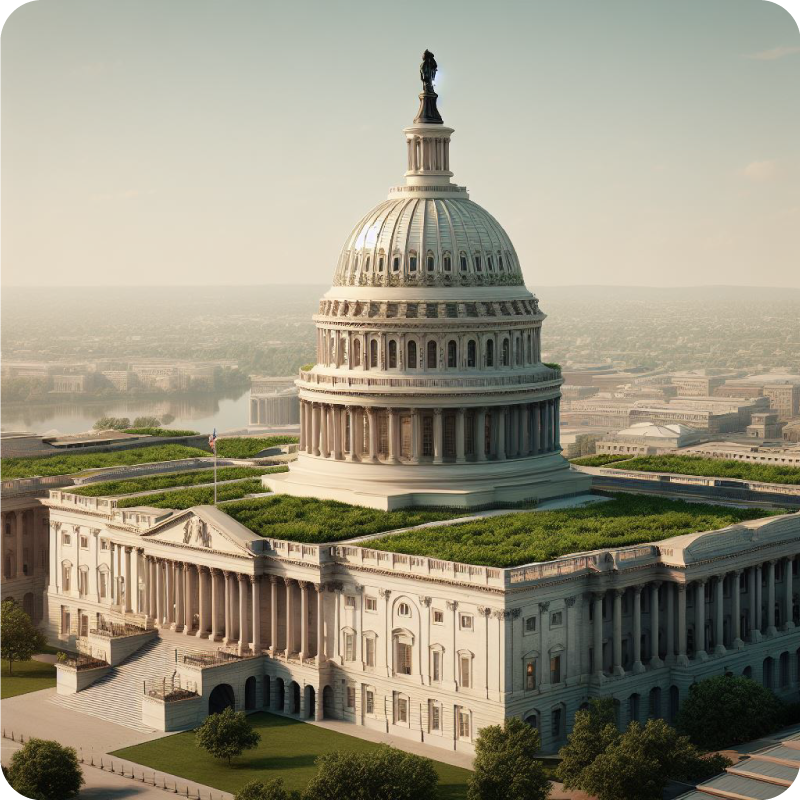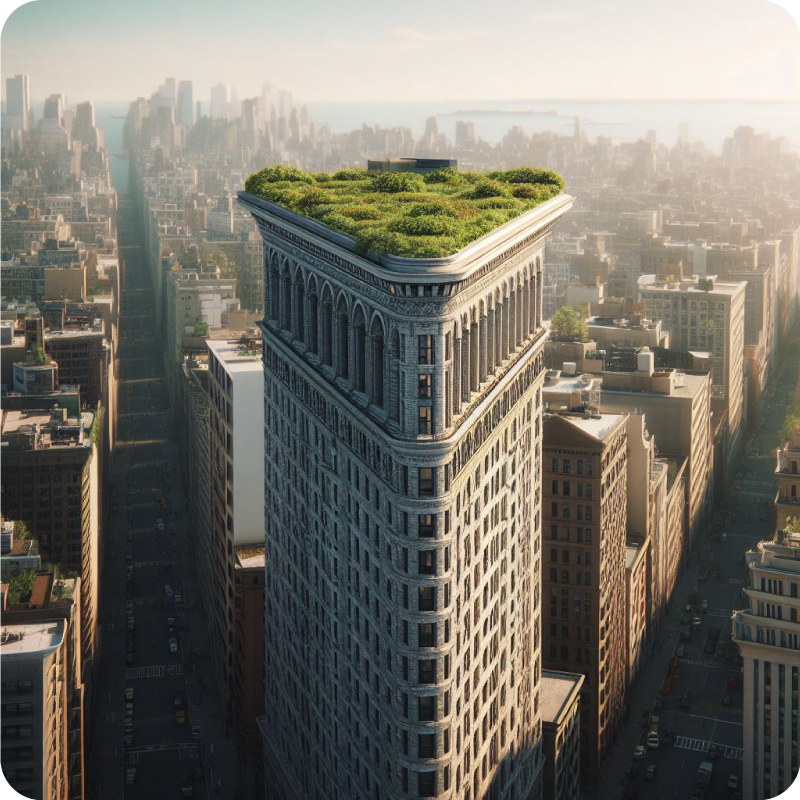Green roofs, also known as vegetative or living roofs, are often considered one of the most expensive roofing options, costing between $10 and $35 per sq.ft. depending on the type and plant coverage. But despite these initial costs, green roofs are becoming popular for their contributions to sustainability and energy efficiency.
In the last two decades, local governments from across North America have been implementing green roof regulations, incentives, and requirements to further the potential of this roofing innovation. The United States is expected to see a 5.1% annual increase in the demand for green roofing systems, potentially reaching a total of $207 million by 2025. So we took a look into a future where this trend is more widespread and used AI to reimagine some of the most famous U.S. buildings with a green roof.
The White House

This image gives us a new take on the White House in Washington, D.C., the residence and office of the President and First Family. It reimagines the building's Neoclassical style, complete with its familiar columns and symmetry, but with a twist: a green, living roof.
Despite the benefits and incentives put in place for the installation of green roofs, their adoption in government buildings, especially historical ones, remains limited. That is, with the exception of Chicago City Hall’s rooftop garden, which was established back in 2000 as part of the Urban Heat Island Initiative. Although a green roof may not be possible for some government buildings due to weight, cost, and security concerns, the White House has explored more sustainable alternatives by opting to install solar panels, demonstrating a commitment to renewable energy.
The Pentagon

This imaginative take on the Pentagon in Arlington, VA, the hub for the Department of Defense, softens up its Stripped Classicism architecture with a living green roof. With an enormous roof area of 6,636,360 square feet, this concept would make for a striking landmark for those flying over the city. Having a green roof would certainly be a win with sustainable living advocates.
In fact, as part of the Biden administration’s clean energy initiative, the Pentagon will soon be embarking on an eco-friendly transformation by installing rooftop solar panels. This initiative points towards a growing trend of integrating renewable energy solutions into historic and iconic buildings, furthering the push towards sustainability and energy efficiency.
The Empire State Building

Here's a different spin on the Empire State Building in New York, NY, known for housing numerous corporate business offices and owned by Empire State Realty Trust Inc. This image layers an eco-friendly twist onto its Art Deco architecture, imagining a green, living roof spread over 79,288 square feet on its different roofing levels. In a concrete jungle, it adds a touch of nature to the world-famous skyline.
The Chrysler Building

This vision of the Chrysler Building in New York with a green roof is a notable transformation for this business office hub, currently owned by SIGNA Group and RFR Holding LLC. Although there is limited space for a green roof due to its design, this concept mixes the building's historic charm with contemporary environmental considerations, offering a greener urban skyline. Yet, there’s an argument to be made about how the Art Deco design of the stainless steel cladding might clash with the greenery.
The United States Capitol

Take a look at the United States Capitol in Washington, DC, the iconic symbol of American democracy and the meeting place of the U.S. Congress, with a green twist. With around 167,932 square feet of flat roof area, it is the perfect candidate for a green roof makeover. AI offers a fascinating blend of tradition and modernity in the image, showing how even government buildings can embrace sustainability while maintaining their historic significance.
Space Needle

Here's a unique take on Seattle's Space Needle, a landmark of Futurist architecture with its sleek, modern lines and soaring height. In this imaginative depiction, parts of its 13,273 square-foot rooftop are transformed with patches of green, living spaces. It's an intriguing idea, showing how even such a futuristic structure can incorporate elements of nature, subtly integrating green spaces into its iconic design. Living roof maintenance at that height could prove tricky, however.
Flat Iron

Another New York icon that could add some much-needed nature to the island of Manhattan is the Flatiron building. The idea of a living roof covering around 10,600 square feet of flat roof offers a touch of nature amidst the cityscape. While probably not visible to passers-by on street level, it would give those neighbors in surrounding taller buildings something new to look at!
Should I Install a Green Roof?
Whether you own a commercial building in the Big Apple or a home in the suburbs, a green roof is an excellent roofing choice. Albeit expensive, a green roof can reduce cooling costs for buildings as well as homes, all while doing a great service to the environment.
Find out more about green roofs in our comprehensive green roof guide here: Green Roofs: A Comprehensive Guide
Adam Graham is a construction industry analyst at Fixr.com. He has experience writing about home construction, interior design, and real estate. He communicates with experts and journalists to make sure we provide the most up-to-date and fact-checked information. He has been featured in publications such as Better Homes and Gardens, and written for various outlets including the National Association of Realtors, and Insurance News Net Magazine.
